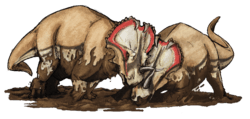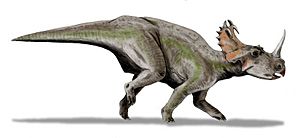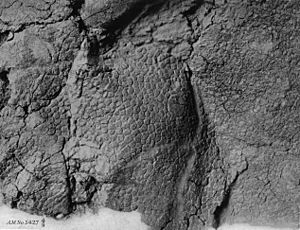Centrosaurus facts for kids
Quick facts for kids CentrosaurusTemporal range: Upper Cretaceous
|
|
|---|---|
 |
|
| Scientific classification | |
| Kingdom: | |
| Phylum: | |
| Class: | |
| Superorder: | |
| Order: | |
| Suborder: | |
| Infraorder: | |
| Family: | |
| Subfamily: |
Centrosaurinae
|
| Genus: |
Centrosaurus
Lambe, 1904
|
| Species | |
|
C. apertus |
|
Centrosaurus (pronounced SEN-tro-SAWR-əs) was a type of plant-eating dinosaur that lived during the late Cretaceous period. Its fossils have been found in Canada. These amazing creatures roamed the Earth about 76.5 to 75.5 million years ago.
The name Centrosaurus means "pointed lizard." This name comes from the small, pointed hornlets found along the edge of its neck frill. It's important not to confuse Centrosaurus with another dinosaur called Kentrosaurus, even though their names sound similar!
Contents
What Did Centrosaurus Look Like?
Centrosaurus had a big body supported by strong, thick legs. It wasn't the biggest dinosaur, growing up to about 6 meters (nearly 20 feet) long. Like other dinosaurs in its group, Centrosaurus had a single large horn over its nose. This horn could curve forwards or backwards, depending on the individual dinosaur.
As these dinosaurs got older, the fancy decorations on their skulls became less noticeable. Centrosaurus is special because it had two large hornlets that curved forward over its neck frill. It also had a pair of small horns above its eyes. The frill itself was medium-sized, with some large openings and small hornlets around its outer edges.
How Were Centrosaurus Fossils Found?
The first Centrosaurus bones were discovered by a scientist named Lawrence Lambe. He found them along the Red Deer River in Alberta, Canada. Later, many huge bonebeds of Centrosaurus were found in Dinosaur Provincial Park, also in Alberta.
Some of these bonebeds stretch for hundreds of meters and contain thousands of individual dinosaurs! Scientists think that so many dinosaurs might have died together while trying to cross a flooded river. One discovery near the town of Hilda is believed to be the largest dinosaur bonebed ever found. It's now known as the Hilda mega-bonebed.
In 2005, a new species called C. brinkmani was described. However, in 2012, scientists decided it was different enough to be placed in its own new group, called Coronosaurus.
How Did Centrosaurus Live?
Like other horned dinosaurs, Centrosaurus had jaws that were perfect for chewing tough plants. Finding so many Centrosaurus fossils together in Canada suggests that they lived in large groups or herds. They likely traveled together, just like some animals do today.
Sometimes, bonebeds are found with both Centrosaurus and Styracosaurus remains. This might mean that during dry times, different types of dinosaurs gathered around the same waterholes. Scientists also noticed that Centrosaurus fossils are found in older rock layers than Styracosaurus. This suggests that Centrosaurus lived in the area before Styracosaurus became more common as the environment changed.
The large frills and horns on the faces of horned dinosaurs are very unique. Scientists have debated for a long time what these features were for. Some common ideas include using them to defend against predators, fighting with other dinosaurs of the same species, or showing off to attract mates.
A study in 2009 looked at injuries on the skulls of Triceratops and Centrosaurus. It found that bone injuries were more likely caused by fights between dinosaurs of the same kind (like horn-to-horn combat) rather than attacks from predators. The frills of Centrosaurus were quite thin, so they probably weren't very good for defense against big predators. However, the thicker frills of dinosaurs like Triceratops might have helped protect their necks. For Centrosaurus, their frills were most likely used to help them recognize other Centrosaurus dinosaurs or for other kinds of visual displays.
Images for kids
See also
 In Spanish: Centrosaurus apertus para niños
In Spanish: Centrosaurus apertus para niños










